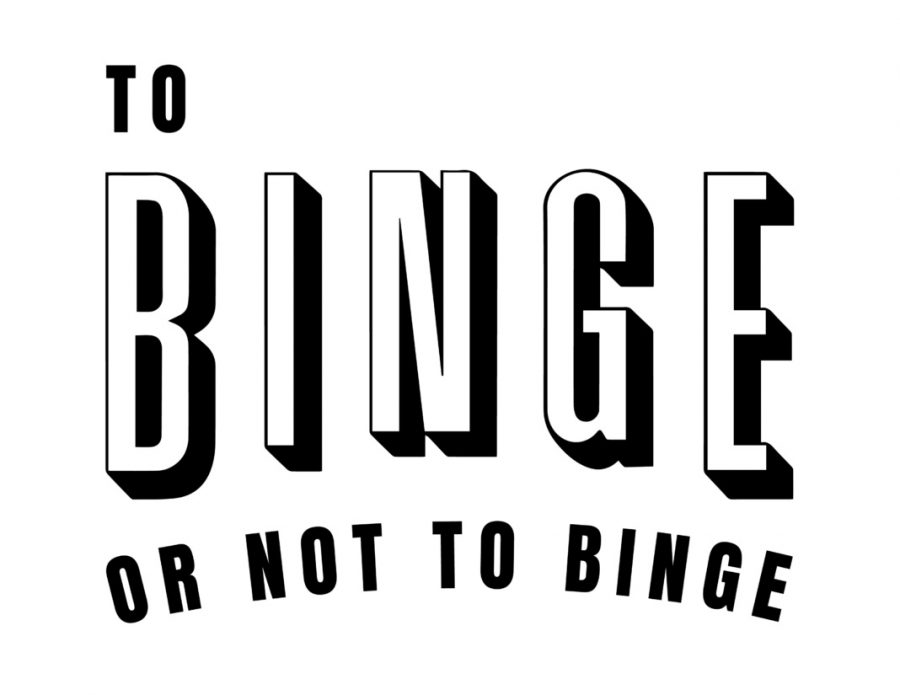To Binge or Not to Binge Episode 66: ‘Mister Rogers’ Neighborhood’
(Graphic by Hannah Allred | The Daily Utah Chronicle)
December 9, 2019
The internet savvy are likely familiar with a certain meme about the “trinity“or “horsemen“of wholesomeness — jokes which point to particular television personalities as prime examples of happy and well-rounded living. These role models often include loveable figures such as Bob Ross, Steve Irwin, Bill Nye and, of course, Mister Rogers.
We’ve already done an episode of TBoNTB on Bill Nye and we’ve yet to tackle “The Joy of Painting,” but today we’ll go over the important question of whether it’s worth it to binge “Mister Rogers’ Neighborhood.” Although it might seem juvenile to watch a children’s series as an adult, “Mister Rogers” has made a lasting impression, if not a comeback, in contemporary culture and media. The 2018 hit “Won’t You Be My Neighbor” stands as the highest-grossing biographical documentary of all time. An animated spin-off series “Daniel Tiger’s Neighborhood” premiered on PBS only a few years ago. Rogers earned his own FunkoPop! design and Tom Hanks is starring as the man himself in the new movie “A Beautiful Day in the Neighborhood.” Rogers’ nonprofit organization, the Fred Rogers Center, currently runs varied international initiatives in several schools and communities.
For those looking for a simple show to wind down with during the evenings or to learn more about self-love and care, Mister Rogers knew his stuff. After all, while he initially earned his bachelor’s in music composition, he also earned 40 honorary degrees from universities across the United States to mark his numerous accomplishments — that’s nothing short of impressive.
To Binge or Not to Binge?
“Mister Rogers’ Neighborhood” is aimed towards children, but the nuggets of wisdom that Rogers shares about life and love throughout his show can teach anybody. It’s worth watching a few episodes no matter how old one is — if not for the entertainment value, than for the educational aspects. For instance, one of the current board leaders of Rogers’ nonprofit had never watched the show as a child, citing that it was his adult viewership of the series that motivated him to get involved with the Fred Rogers Center’s charity work. Though Rogers spoke primarily to his intended kid audiences, he likewise shared his messages of kindness and warmth with listening parents, caretakers and teachers, too. There’s a lot of useful knowledge that any adult can take from the philosophies of “Mister Rogers’ Neighborhood.”
On a personal note, watching “Mister Rogers” has been a help to me to get over a nasty patch of depression just last year. At that moment, I’d grown sick of seeing any amount of negativity on TV, to the point where I couldn’t withstand watching the standard violence or drama of some of my own favorite series without feeling bummed out. Really, I needed to introduce more positivity into my life at that time. After reading about how Mister Rogers went into television because he disliked much of the pessimism that existed in it, I decided to take a nostalgic trip through his “Neighborhood.” I’m glad I made that choice. The series proved effective and helped me, if just a little, to overcome my own hurdles.
Besides Rogers’ open talks with viewers about emotional management, friendship and being true to oneself, his series is also enjoyable for other reasons. The light comedy of Rogers’ characters in the Land of Make Believe is pretty stinking cute, for one. His show also featured a number of special guests who he interviewed and did activities with, including Yo-Yo Ma, Koko the gorilla, Julia Child and Levar Burton.
Of course, Rogers also made a variety of well-known episodes in his series of factory tours in order to explain to viewers how commonplace items like toys, food and clothes are produced by everyday people, each of which is — visually — incredibly satisfying to watch. In any case, whether one chooses to incorporate “Mister Rogers” into a regular TV routine, select a single episode for a throwback or half-watch it alongside their own youngsters, the series is a fantastic pick. On the other hand, to any looking for a dose of Rogers without having to watch his show, you might instead enjoy reading some of his books. (I recommend “The World According to Mister Rogers,” a collection of his best song lyrics and quotes, for casual, occasional reading.)
Best Episode
It’s impossible to go wrong in choosing an episode of Mister Rogers. Additionally, it doesn’t especially matter to follow any certain order to watch the series through. Nonetheless, one may wish to look for an episode based on a certain guest or activity which Rogers did that catches their own particular interests, such as the episode with Bill Nye’s visit for science geeks or the one featuring a brief tour of the Crayola crayon factory for art lovers. It’s also a safe bet to look up episodes according to different topics, such as disability, racism, adoption and so on.
However, I will gladly suggest “Mister Rogers Tells Us About His Work,” season 15, episode 30, in which Mister Rogers demonstrated to viewers how his own show was produced.
Similar Shows
“Mister Rogers’ Neighborhood” shares similarities with programs like “Reading Rainbow,” “Sesame Street,” “Bill Nye the Science Guy” and “The Joy of Painting.”
Trigger Warnings
“Mister Rogers’ Neighborhood” is a friendly series to all and Rogers always spoke with respect, consideration and care. However, it’s worth noting that he was blunt about serious topics that other children’s programs don’t always go near, such as death, war, anger and familial contention.
“Mr. Rogers’ Neighborhood”
5 out of 5 stars, as Rogers deserves nothing less.
Available to stream through Amazon Prime, PBS and at misterrogers.org.
31 Seasons, 895 Episodes, approximately 450 hours












